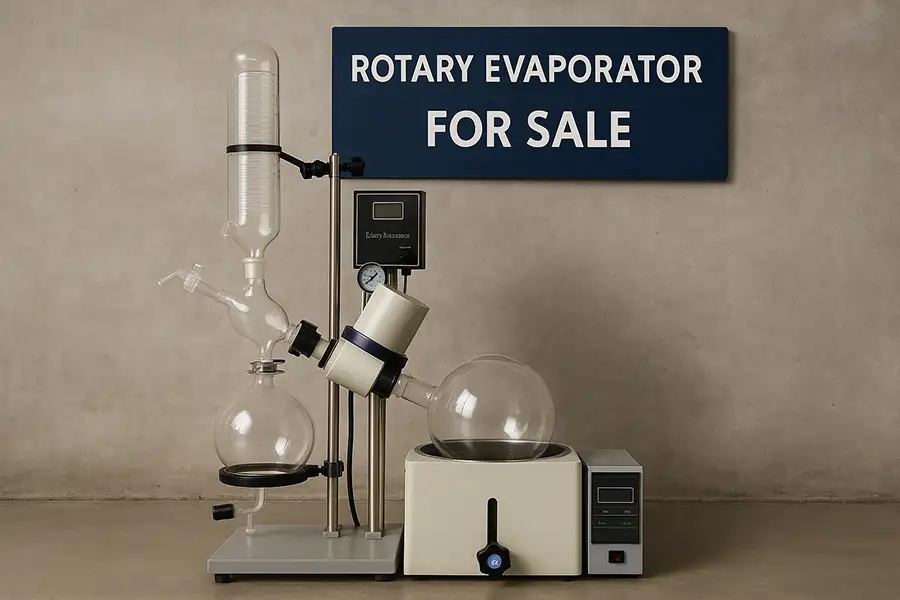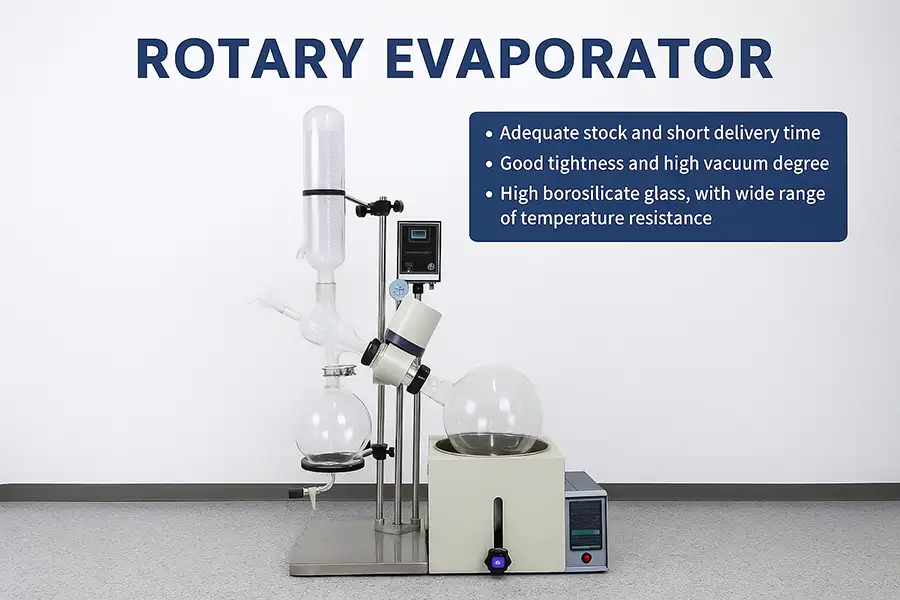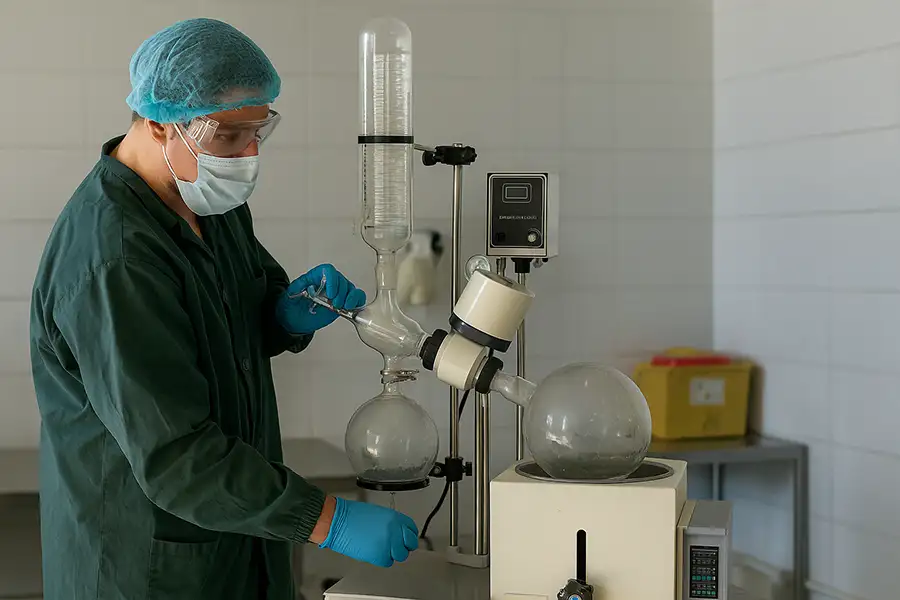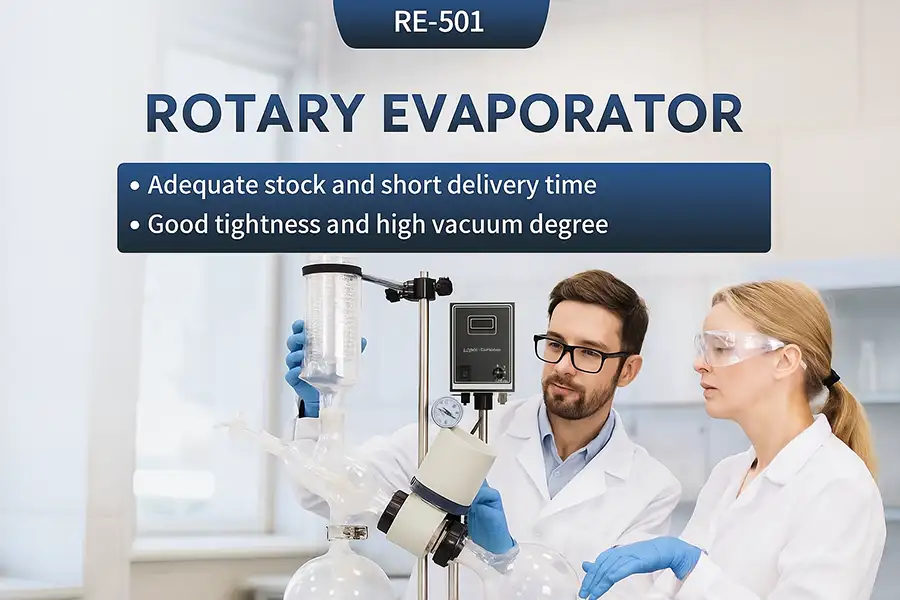Rotary Evaporator for Sale: A Complete Guide
Understanding rotary evaporator machines, their applications, and how to choose the ideal solution for your lab or industrial needs.
Explore ModelsWhat is a Rotary Evaporator?
The essential tool for solvent removal in modern laboratories.
A rotary evaporator, often called a "rotovap", is a specialized laboratory device designed for the efficient, gentle removal of solvents from samples via evaporation. It combines reduced pressure, controlled heating, and rotating motion for optimal solvent extraction while preserving sensitive compounds.
Rotary evaporators have become indispensable in chemistry, biochemistry, and pharmaceutical industries due to their ability to process solvents without damaging heat-sensitive materials.

Efficient Evaporation
Removed solvents 50% faster than conventional methods
Temperature Control
Preserves heat-sensitive compounds and materials
Enhanced Safety
Built-in safety features minimize operational risks
Versatile Applications
Works across multiple industries and solvent types
How Does a Rotary Evaporator Work?
Rotary evaporators operate on a sophisticated principle: samples in a rotating flask are partially submerged in a heated bath. The rotation creates an optimal evaporation surface area, while simultaneous vacuum pressure reduces the solvent's boiling point, enabling low-temperature vaporization.
Sample Loading & Rotation
The sample is placed in a rotating flask that increases surface area for evaporation
Vacuum Application
Reduced pressure significantly lowers the boiling point of solvents
Controlled Heating
The flask rotates in a water bath at precise temperature settings
Vapor Condensation
Solvent vapors travel to a cooled condenser for liquefaction
Solvent Collection
Liquefied solvent collects in a receiving flask for disposal or reuse

Applications of Rotary Evaporators
Pharmaceutical Research
Drug discovery and purification processes
Natural Product Extraction
Essential oils and plant-derived compounds
Food & Beverage Industry
Concentration of flavors and aromas
Environmental Analysis
Water sample concentration for testing
Industry Impact
According to MIT LabTech Research, automation integration in rotary evaporators has increased processing efficiency by 38% and reduced solvent costs by 27% in pharmaceutical manufacturing.
Advanced rotovap systems with automation are projected to increase lab productivity by over 25% by 2035, making them crucial investments for any research facility.
Choosing the Right Rotary Evaporator
Selecting the right rotary evaporator depends on your sample volume, solvent characteristics, and workflow requirements. Each model offers distinct advantages based on your laboratory's needs.
| Model | Capacity | Rotation Speed | Temperature Range | Application | Details |
|---|---|---|---|---|---|
| RE-201D | 2L | 10-180 RPM | 0-99°C | Small-scale lab work | Learn More |
| RE-501 | 5L | 10-180 RPM | -20~99°C | Medium-scale research | View Details |
| RE-1002 | 10L | 10-120 RPM | -20~99°C | Industrial pilot scale | Industrial Use |
| RE-5002 | 50L | 5-80 RPM | RT~90°C | Large-scale production | Production Model |
Safety & Maintenance
Proper maintenance extends equipment lifespan and ensures optimal performance:
Daily Inspection Checklist
Examine vacuum seals to prevent leaks
Check bath fluid level and quality
Ensure ventilation holes remain unobstructed
Monthly Maintenance Routine
Clean glass components with appropriate solvents
Lubricate moving components as recommended
Calibrate temperature and rotation controls
Vacuum Pump Care
Regularly change oil (for oil-based pumps)
Check for unusual noises or vibrations
Monitor pump performance metrics

Where to Find Rotary Evaporators
When evaluating rotary evaporators for sale, prioritize established suppliers with comprehensive product offerings:
Manual Rotary Evaporators
Best SellerPerfect for laboratories requiring precision control
Large Scale Production Systems
PopularFor industrial applications requiring continuous operation
Advanced Laboratory Models
New ArrivalDigitally controlled systems with automation features
Professional Advice
Selecting the right rotary evaporator requires consideration of:
Volume requirements per batch
Solvent characteristics and evaporation points
Automation and safety protocols needed
Space constraints and compatibility
Conclusion
Rotary evaporators have become foundational equipment in modern chemical processing across industries.
With their advanced solvent removal capabilities, precise temperature controls, and adaptability to diverse applications, rotary evaporators provide critical efficiency in both research settings and industrial-scale operations.
Investing in appropriate rotary evaporation technology, whether for initial discovery research (2-5L) or production-scale manufacturing (10-50L), delivers tangible benefits:
Superior compound preservation
Maintains stability of sensitive molecules through low-temperature evaporation
Significant cost savings
Reduces solvent consumption by up to 30% compared to conventional methods
Enhanced productivity
Automated systems allow unattended operation for overnight processing
Have Questions?
Our lab equipment specialists are available to help you:
Identify optimal system configuration
Provide technical documentation
Arrange equipment demonstrations
Discuss application requirements

E-mail:
WhatsApp:
Address:
19/F, Block B, Guohong Mansion, Hi-Tech Development Zone, Zhengzhou City, Henan Province, China
Related blogs
You May also like
Rotary Evaporator Parts – Complete Guide for Laboratory Use
Master rotary evaporator components with our definitive guide. Explore parts diagrams, maintenance protocols, and selection criteria for laboratory systems. D...
Read MoreRotary Evaporator Chemistry Explained
Explore the essential role of rotary evaporator chemistry in modern laboratories. This comprehensive guide explains how rotovaps work, their core components, ...
Read MoreHow to Use Rotary Evaporator - Complete Guide for Laboratory Work
Master rotary evaporator operation with our comprehensive laboratory guide. Step-by-step instructions, safety protocols, efficiency tips, and model selection ...
Read More


